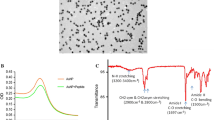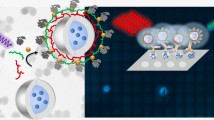Abstract
Newcastle disease, an economically important endemic OIE (World Organisation for Animal Health) listed viral disease remains a major impediment to the vibrant status of the poultry industry. The outbreak of the disease leads to huge economic loss posing a major threat to the Country’s economy. To detect the disease outbreak, an effective tool is required. The present study is a first step in forming a peptide nanoparticle conjugate as an attempt to develop a biosensor for NDV outbreak detection. ZnS due to its emission properties and photo stability, it was used as fluorescent labels in immunoassays. ZnS is widely used as the shell material in most luminescent core–shell nanoparticles. In this study, ZnS was used as the core material and the ZnS–PEG modified with the carboxylic acid group functionalized nanoparticles were prepared by a simple wet chemical method. To the ZnS–PEG–COOH nanoparticle, Newcastle disease virus peptide was attached using EDC/NHS coupling and analyzed. Structural properties of the ZnS, ZnS–PEG and ZnS–PEG–COOH nanoparticles were analyzed using X-ray diffraction (XRD), Fourier-transform infrared spectroscopy (FTIR), scanning electron microscope (SEM) and dynamic light scattering (DLS). FTIR peak at 2364 cm−1 indicates the formation of S–H bond which confirms the attachment of PEG to ZnS surface by S–H bond formation. The XRD, FTIR, DLS and optical study such as UV–Vis results support the particle size reduction upon capping ZnS with PEG and dicarboxylic-terminated PEG. The optical properties were studied using Photoluminescence (PL) and UV–visible Spectra. PL result shows upon capping ZnS with PEG-COOH, the fluorescence intensity increased by ≈ 5 times more than that of the bare ZnS nanoparticles. ZnS–PEG–COOH found to have superior photo luminescent property. NDV peptides were tagged by means of EDC/NHS activation to ZnS–PEG–COOH. The peptide conjugation was confirmed by UV–Vis spectral analysis and the peak was found to be shifted by 4 nm which confirms the attachment of NDV peptide on the surface of ZnS–PEG–COOH nanoparticle. Hence ZnS–PEG–COOH nanoparticle is found to be suitable option for attaching biomolecule which can be further extended for bio sensing application of NDV detection.












Similar content being viewed by others
References
Ahemen I, Amah AN, Kalu O (2013) Passivative effect of polyethylene glycol and carboxyl methyl cellulose as capping agents on particle size of ZnS nanoparticles. Adv Phys Theor Appl 21:9–21
Alexander DJ (1995) The epidemiology and control of avian influenza and Newcastle disease. J Comp Pathol 112(2):105–126
Bello MB, Yusoff K, Ideris A, Hair-Bejo M, Peeters BPH, Omar AR (2018) Diagnostic and vaccination approaches for newcastle disease virus in poultry: the current and emerging perspectives. Biomed Res Int 2018:1–18
Benmouna R, Rächet V, Le Barny P, Feneyrou P, Maschke U, Coqueret X (2006) Polymer dispersed liquid crystals with nanosized droplets: SEM, FTIR and UV spectroscopy studies. J Polymer Eng. https://doi.org/10.1515/POLYENG.2006.26.7.655
Bhushan M, Jha R, Bhardwaj R (2019) Reduced band gap and diffusion controlled spherical n-type ZnS nanoparticles for absorption of UV-Vis region of solar spectrum. J Phys Chem Solids 135:109021
Cholan S, Shanmugam N, Kannadasan N, Sathishkumar K, Deivam K (2014) Effect of poly ethylene glycol (PEG) as surfactant on cerium doped ZnS nanoparticles. J Market Res 3(3):222–227
Department of Animal Husbandry and Dairying (2020) Annual report 2019. Ministry of Fisheries, Animal Husbandry and Dairying, Government of India, India
Ding Y, Cong T, Chu X, Jia Y, Hong X, Liu Y (2016) Magnetic-bead-based sub-femtomolar immunoassay using resonant Raman scattering signals of ZnS nanoparticles. Anal Bioanal Chem 408(18):5013–5019
Dumbrava A, Berger D, Prodan G, Moscalu F, Diacon A (2017) Considerations about the dependence of PEGylated ZnS nanoparticles properties on the synthesis method. Z Phys Chem 232(1):61–77
Dvorakova V, Cadkova M, Datinska V, Kleparnik K, Foret F, Bilkova Z, Korecka L (2017) An advanced conjugation strategy for the preparation of quantum dot-antibody immunoprobes. Anal Methods 9:1991–1997
Fang X, Zhai T, Gautam UK, Li L, Limin Wu, Bando Y (2011) ZnS nanostructures: from synthesis to applications. Prog Mater Sci 56:175–287
Fengqin Hu, Li Z, Chifeng Tu, Gao M (2007) Preparation of magnetite nanocrystals with surface reactive moieties by one-pot reaction. J Colloid Interface Sci 311:469–474
Ghoderao KP, Jamble SN, Sawant JP, Kale RB (2017) Solution assisted growth mechanism and characterization of ZnS microspheres. Mater Res Express 4:025026
Guerrini L, Alvarez-Puebla RA, Pazos-Perez N (2018) Surface modifications of nanoparticles for stability in biological fluids. Materials 11(7):1154
Hudlikar M, Joglekar S, Dhaygude M, Kodam K (2012) Latex-mediated synthesis of ZnS nanoparticles: green synthesis approach. J Nanopart Res 14:865
Jokerst JV, Lobovkina T, Zare RN, Gambhir SS (2011) Nanoparticle PEGylation for imaging and therapy. Nanomedicine 6(4):715–728
Keleştemur S, Altunbek M, Culha M (2017) Influence of EDC/NHS coupling chemistry on stability and cytotoxicity of ZnO nanoparticles modified with proteins. Appl Surf Sci 403:455–463
Kumar R, Sakthivel P, Mani P (2019) Structural, optical, electrochemical, and antibacterial features of ZnS nanoparticles: incorporation of Sn. Appl Phys A 125:543
Mohammed AF, Salah WR (2018) Synthesis of ZnS quantum dots for QDs-LED hybrid device with different cathode materials. J Phys Conf Ser 1032:012010
Mustafaoglua N, Kiziltepea T, Bilgicer B (2017) Site-specific conjugation of antibody on gold nanoparticle surface for one-step diagnosis of prostate specific antigen with dynamic light scattering. Nanoscale 9(25):8684–8694
Raleaooa PV, Roodt A, Mhlongo GG, Motaung DE, Kroon RE, Ntwaeaborwa OM (2017) Luminescent, magnetic and optical properties of ZnO-ZnS nanocomposites. Physica B Condens Matter 507:13–20
Ravindran A, Singh A, Raichur AM, Chandrasekaran N, Mukherjee A (2010) Studies on interaction of colloidal Ag nanoparticles with bovine serum albumin (BSA). Colloids Surf B 76(1):32–37
Rubi Tamrakar M, Ramrakhiani BPC (2008) Effect of capping agent concentration on photo physical properties of zinc sulfide nanocrystals. Open Nano Sci J 2:12–16
Sharma P, Brown S, Walter G, Santra S, Moudgil B (2006) Nanoparticles for bioimaging. Adv Coll Interface Sci 123–126:471–485
Sharma M, Sen S, Gupta J, Ghosh M, Pitale S, Gupta V, Gadkari SC (2018) Tunable blue-green emission from ZnS (Ag) nanostructures grown by hydrothermal synthesis. J Mater Res 33(23):3963–3970
Thinh TQ, Quan TV, Thuy TH, Xuan CT, Tuan MA (2019) A label-free electrochemical immunosensor for detection of newcastle disease virus. In: 7th international conference on the development of biomedical engineering in vietnam (BME7), pp 699–703
Wang GZ, Geng BY, Huang XM, Wang YW, Li GH, Zhang LD (2003) A convenient ultrasonic irradiation technique for in situ synthesis of zinc sulfide nanocrystallites at room temperature. Appl Phys A Mater Sci Process 77(7):933–936
Wang Yu, Yoyun W, Wanxia W (2018) Synthesis and characterization of carboxyl-terminated polyethylene glycol functionalized mesoporous silica nanoparticles. J Wuhan Univ Technol Mat Sci Edit 33:1540–1545
Wang Z, Wang S, Liu Z, Zhou B, Wen Y, Lu Z, Chen R, Shan B (2021) Bonding behavior and passivation mechanism of organic ligands (-SH,-NH2,-COOH) on ZnS (101¯ 0) surface from first-principles calculations. Appl Surf Sci 545:148970
Wu J, Lin W, Wang Z, Chen S, Chang Y (2012) Investigation of the Hydration of nonfouling material poly (sulfobetaine methacrylate) by low-field nuclear magnetic resonance. Langmuir 28(19):7436–7441
Yi TF, Li Y, Li YM, Luo S, Liu YG (2019) ZnS nanoparticles as the electrode materials for high-performance supercapacitors. Solid State Ionics 343:115074
Zhou DJ, Xie XY, Zhang YL, Guo DY, Zhou YJ, Xie JF (2016) Facile synthesis of ZnS nanorods in PEG and their spectral performance. Mater Res Express 3(10):105023
Acknowledgements
We acknowledge the Department of Physics and Nanotechnology for their great support in extending their facilities to synthesize and characterize the nanoparticles. We acknowledge Tamilnadu Veterinary and Animal Sciences (TANUVAS), Veppery, Chennai for providing us the NDV peptide samples and also their technical guidance. The authors thank the Department of Microbiology, SRM Medical College Hospital & Research Centre, Kattankulathur for their extensive support in providing us the laboratory facilities to carry out the bio conjugation of the nanoparticles. The authors thank VELS University for extending its Dynamic Light Scattering facility. Our sincere acknowledgement to Nanotechnology Research center (NRC) and Research Institute, SRMIST for their support in the characterization of the samples through their equipment facilities.
Author information
Authors and Affiliations
Corresponding author
Ethics declarations
Conflict of interest
The authors have no conflicts of interest to declare that are relevant to the content of this article.
Additional information
Publisher's Note
Springer Nature remains neutral with regard to jurisdictional claims in published maps and institutional affiliations.
Rights and permissions
About this article
Cite this article
Deepa, N., Aanantharaj, K., Vimala Juliet, A. et al. Suitability of PEG capped carboxylic acid terminated fluorescent ZnS nanoparticles for NDV peptide binding. Appl Nanosci 11, 2337–2346 (2021). https://doi.org/10.1007/s13204-021-02013-0
Received:
Accepted:
Published:
Issue Date:
DOI: https://doi.org/10.1007/s13204-021-02013-0




